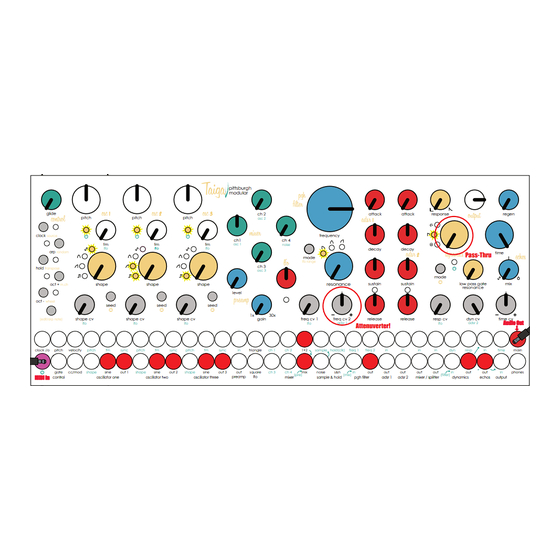Subscribe to Our Youtube Channel
Summary of Contents for Pittsburgh Modular Taiga
- Page 1 Taiga Tuning Guide Taiga Hardware Calibration V1.0.1 Taiga is a trademark of Pittsburgh Modular LLC. Copyright © Pittsburgh Modular LLC. 2023...
-
Page 2: Necessary Tools
If you experience a performance issue or simply wish to keep your Taiga running at its very best, this guide will walk you through the process of retuning each element of the instrument. - Page 3 Taiga CAUTION In order to access the calibration trimmers, the Taiga module must be separated from the metal frame. However, a few words of warning first… Adjusting the trimmers on Taiga takes care and patience. It also requires you to make adjustments to the circuitry while the instrument is powered on.
- Page 4 C2 (~65 Hz) from the oscillator. You may need to adjust the octave settings on your controller or on Taiga to get it in range. Once it is close, adjust the [Osc 1 Pitch Knob] to an exact C2.
- Page 5 Pitch Tuning Taiga Adjust the [Pitch Knob] so that the reading is once again a perfect C2 Go back up to C6 and measure the new tuning offset Repeat the process of adjusting the offset at C2 with the [PITCH 1 Trimmer] and retuning it to C2 with the [Pitch Knob] until C2 and C6 are perfectly in tune with each other.
- Page 6 Oscillator Pitch Knob Centering Taiga B) Oscillator Pitch Knob Centering Ideally, each of your oscillators will be in tune when the [Pitch Knob] is set to center (12 o’clock). This means that when you play a C note with your keyboard, a C note will play from the oscillator.
- Page 7 Oscillator Output Starting Amplitude Taiga C) Oscillator Output Starting Amplitude The shaping section of each oscillator uses an amplifier to feed the wave folding circuitry. The [Shape Knob] controls the strength of this amplifier. Ideally, when the [Shape Knob] is turned fully to the left (counterclockwise), the signal from the [Oscillator Out Jack] will be a full-sized, but unfolded waveform.
- Page 8 Taiga D) Triangle Shape Adjustment Taiga uses a cascading wave shape architecture, in which various core shapes are created out of previous shapes. The first adjustment in the chain uses the [SAW 1 Trimmer] to set the DC offset of the Saw wave being sent into the Triangle shaper. Adjusting this offset allows the Triangle wave to be fine tuned into a perfect triangle shape 1) Connect your audio output to the [Osc 1 Out 1Jack].
- Page 9 Oscillator Triangle Shape Adjustment Taiga E) Sine Wave Adjustment The Sine wave is created from the Triangle wave. Depending on the DC offset of the Triangle wave being fed into the Sine shaping circuit, the resulting wave will be more or less symmetrical.
- Page 10 Dynamics Cutoff Point Adjustment Taiga F) Dynamics Cutoff Point Adjustment The [Dynamics Knob] is unique in that it controls both the volume (VCA) and upper harmonic content (lowpass filter) of audio. With the [Dynamics Knob] turned fully to the left (counterclockwise), the VCA portion will be completely silent. However, the lowpass filter requires a bit of fine tuning in order to completely silence the signal.
- Page 11 Dynamics Response Range Adjustment Taiga G) Dynamics Response Range Adjustment The [Response Knob] allows you to adjust the decay time when in lowpass gate mode. The overall range of this control is set using the [Dyn Length Trimmer]. While there is a factory specification for this setting, this is the most subjective adjustment on the instrument and can be set to your personal preference.
- Page 12 Echos Delay Adjustment Taiga H) Echos Delay Adjustment The analog delay (Echos) section is a complex circuit with a variety of calibration adjustments. A full recalibration should not be necessary once it has been calibrated at the factory. However, each trimmer can be adjusted as needed to improve the overall...
- Page 13 Advanced Taiga Adjustments Taiga I) Advanced Calibrations The following adjustments require familiarity with a multimeter and the ability to probe test points on the circuit board without causing damage. These calibrations should not be attempted unless you are experienced with this tool and are sure that adjustments need to be made in these sections.
- Page 14 Advanced Taiga Adjustments Taiga TEMP Calibration Each of the 3 oscillators has a static DC voltage applied to the core which is designed to compensate for tuning drift during temperature changes. When set properly, the overall scaling of each oscillator should not change dramatically between a cold start and full stabilized running temperature.







Need help?
Do you have a question about the Taiga and is the answer not in the manual?
Questions and answers